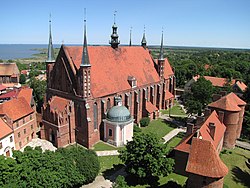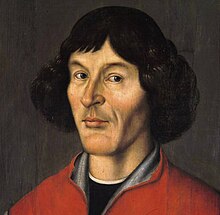Frombork
Frombork | |
|---|---|
 Frombork Cathedral, with Vistula Lagoon in background. | |
| Country | |
| Voivodeship | Warmian-Masurian |
| County | Braniewo |
| Gmina | Frombork |
| Established | 13th century |
| Town rights | 1310 |
| Government | |
| • Mayor | Krystyna Ryszarda Lewańska |
| Area | |
| • Total | 7.59 km2 (2.93 sq mi) |
| Population (2006) | |
| • Total | 2,529 |
| • Density | 330/km2 (860/sq mi) |
| Time zone | UTC+1 (CET) |
| • Summer (DST) | UTC+2 (CEST) |
| Postal code | 14-530 |
| Area code | +48 55 |
| Car plates | NBR |
| Website | http://www.frombork.pl |
Frombork [ˈfrɔmbɔrk] (Template:Audio-de) is a town in northern Poland, on the Vistula Lagoon, in Braniewo County, Warmian-Masurian Voivodeship. It had a population of 2,528 as of 2005[update].
The town was first mentioned in the 13th century. In the early 16th century it was the residence of the astronomer Nicolaus Copernicus, who used it as a site for several of his observations. The town and its 700-year-old cathedral were badly damaged in World War II. The German population was expelled and replaced by Poles who had themselves been expelled from former Eastern Poland by the Soviets. After the war the cathedral was meticulously reconstructed and is again a popular tourist destination.
Frombork is known as “The Jewel of Warmia” because of its many historical sites. The Museum of Copernicus in Frombork [1] holds exhibitions related to the astronomer, as well as to astronomy in general, and includes a planetarium. One of the biggest attractions is also the annual International Festival of Organ Music, held every summer. Between 1975 and 1998 the town was part of the Elbląg Voivodeship.
History
Early history
The town was founded as a defensive stronghold on an Old Prussian site. In 1224 at Catania, Emperor Frederick II declared Prussia directly subordinate to the church and Holy Roman Empire. Later in the same year the pope assigned Bishop William of Modena as the papal legate to Prussia. With the imperial Golden Bull of Rimini, the Teutonic Knights were granted control of the region, which they subsequently conquered. According to local legend, the Old Prussian inhabitants were baptised by Anselm of Meissen[citation needed], a priest of the Teutonic Knights and the first Bishop of the Bishopric of Warmia which was created in 1242 by William of Modena.
Supposedly when the stronghold's lord died, his widow Gertruda offered the settlement to the bishop, and in her honor it was named "Frauenburg" (German for "Our Lady's fortress", "Castrum Dominae Nostrae"[2] in Latin). This name is not unique in German, as it usually originates in the construction of a fortified chapel, church, or monastery dedicated to the Virgin Mary or inhabited by nuns. Several places were thus named Frauenburg or Marienburg, like the nearby Marienburg castle and city (now Malbork).
The village was first mentioned in a 1278 document signed by Bishop Heinrich Fleming. On 8 July 1310, Bishop Eberhard of Neisse granted the town Lübeck city rights, as used by many member cities of the Hanseatic League. It was described, still rather unspecifically, as Civitas Warmiensis (Warmian city).
In 1329-1388, the magnificent Brick Gothic cathedral (now the Archcathedral Basilica of the Assumption of the Blessed Virgin Mary and Saint Andrew) was built, and was dedicated to the Virgin Mary, or "Our Lady" (in Latin, Domina Nostra; in German, Unsere Frau). Hence, the town was called Frauenburg.
Over the centuries, the cathedral has been expanded and rebuilt repeatedly. There are also several other historic churches, dedicated to St. Nicholas, St. George, and St. Anne, all built in the 13th century.
Copernican era


Altes und neues Preussen, Christoph Hartknoch

In 1414 the city was plundered and burned during the Hunger War between the Teutonic Knights and Poland. In 1454, during the Thirteen Years' War, the hill and its cathedral were occupied by Jan Skalski.[3] By the Second Peace of Thorn (1466), it became an important city of the Prince-Bishopric of Warmia and part of the Polish province of Royal Prussia. The city was also devastated after a raid by Albrecht of Brandenburg in 1520.[3]
In the Middle Ages, the inhabitants were mainly merchants, farmers and fishermen. The most famous resident was the astronomer and mathematician Nicolaus Copernicus, who lived and worked here as a canon (1512–16 and 1522–43). Copernicus is said to have jokingly called it "Weiberstadt"[4] ("Wives' Town") or "Gynepolis" (in Medieval Greek). In 1519 Copernicus wrote to the King of Poland, asking for help against the Teutonic Knights who were threatening the city. The letter however was intercepted, and the Teutonic Knights took and burned the city (Copernicus and other canons had left the city shortly before).[5]
The astronomer wrote his epochal work, De revolutionibus orbium cœlestium in Frombork, northeastern Poland.[6] In his book, written in Latin, Copernicus used the Latin name of the town and region - Frueburgo Prussiae [7][8][9][10][11] Shortly after its 1543 publication, Copernicus died there and was buried in the town's cathedral, where his grave was thought to have been found by archaeologists in 2005. This was subsequently confirmed in November 2008 by the publication of the results of DNA tests on fragments of bone and hair found on the skeleton: hair that matched two strands of hair which belonged to Copernicus and are currently located in Uppsala University.[12]
In the northwest corner of the cathedral grounds is Copernicus' tower, and in the southwest corner an octagonal building with a square bell tower and a small planetarium and a Foucault's pendulum. From atop the tower one can survey the town, the tiny harbor, the great panorama of the Baltic Sea, and much of Warmia's countryside.
The city also suffered destruction and heavy population losses during the Polish–Swedish wars. Between 1626 and 1635 it was occupied by Gustavus Adolphus of Sweden who looted the cathedral and shipped many cultural artifacts, including Copernicus' manuscripts to Sweden. Further destruction followed during the Deluge (Swedish invasion of Poland), the Great Northern War and the War of the Fourth Coalition.[3]
Modern history
After the first partition of the Polish-Lithuanian Commonwealth (1772) the town was taken over by the Kingdom of Prussia. Subsequently, in 1871 Frauenburg became part of the German Empire. The Preußische Ostbahn railway line was opened in 1899 connecting Elbing (Elbląg) and Braunsberg (Braniewo) via Frauenburg, leading further to the Russian border at Eydtkuhnen (Chernyshevskoye). Passenger services on the railway line ceased in early 2006.
Towards and after the end of World War II the German inhabitants were either evacuated or expelled like most of the German population of East Prussia. At the end of World War II, 173 years after the partitions, the city along with the rest of southern East Prussia became again part of Poland by the decisions of the Potsdam Conference. The town was resettled by Poles, many of whom were expellees from Polish areas annexed by the Soviet Union.
In 1959 Frombork regained its city rights. Having been heavily (70%) damaged in World War II, it was rebuilt by Polish Boy Scouts in 1966-1973, in time for the 500th anniversary of Copernicus' birth.
Today, Frombork is regaining its importance as a tourist destination, abetted by its key location just south of the frontier with the Russian district of Kaliningrad. Although the railway through Frombork closed in 2006, the port has seasonal ferry connections with Elbląg, Krynica Morska and Kaliningrad.

Political timeline
- 1278 first mentioned
- 1310 Lübeck law rights granted for Civitas Warmiensis
- 1388 cathedral completed and dedicated to the Virgin Mary
- 1466 Second Peace of Thorn (1466): now part of the Prince-Bishopric of Warmia and Royal Prussia in Poland
- 1772 First partition of Poland: now part of the Kingdom of Prussia
- 1871 German Empire founded: now automatically a part of it
- 1945 The Potsdam Conference places Frombork under the administration of Poland pending a final peace conference, but since one never takes place, the decision effectively passes the town to Poland. The new borders are recognized by East Germany in 1950, accepted by West Germany in 1970, and confirmed by the newly reunified Germany in 1990 [13]
Monuments

Several monuments are on display in Frombork (see external links):
- monument to Nicolaus Copernicus, was replaced in the mid-1950s as the monument erected by Imperial Germany's Wilhelm II was destroyed in WW II
- monument honoring Red Army soldiers, inscribed: "Glory to the Red Army heroes fallen in liberating Frombork"
- monument to people of East Prussia who drowned in the Vistula Lagoon during the 1945 exodus, made from a glacial erratic rock found in the water
- memorial honoring the Boy Scouts and others who took part in "Operation 1001" 1966-73, the rebuilding of the town from its devastation in World War II
- Copernicus' astronomical observatory, work room, instruments and planetarium are on display at Frombork's Copernicus Museum
Twin towns – sister cities
Frombork is twinned with three cities:[14]
 Kazlų Rūda, Lithuania
Kazlų Rūda, Lithuania Sucha Beskidzka, Poland
Sucha Beskidzka, Poland Svetly, Russia
Svetly, Russia
References
- Notes
- ^ Wojciech Jan Janeczek. "Muzeum". Frombork. Retrieved 2011-09-16.
- ^ Zapiski historyczne, by Towarzystwo Naukowe w Toruniu, Published by Państwowe Wydayn. Naukowe, 2006 [1]
- ^ a b c Serwis Internetowy Miasta Frombork, "Historia Miasta" (History of the City), [2]
- ^ Hermann Kesten: Copernicus und seine Welt, [3]
- ^ Barbara A. Somervill, "Nicolaus Copernicus: Father of Modern Astronomy", Compass Point Books, 2005, pgs. 45-46, [4]
- ^ J R Ravetz Plate, Nicolaus Copernicus 1473-1543 in Proceedings of the Royal Society of London, London 1602, p. 7 link
- ^ Frueburgo=Frauenburg, Prussia
- ^ "Pagina:Nicolai Copernici torinensis De revolutionibus orbium coelestium.djvu/142 - Wikisource" (in Latin). La.wikisource.org. 2011-07-16. Retrieved 2011-09-16.
- ^ On his manuscript on page 72 recto (edited) - http://www.bj.uj.edu.pl/bjmanus/revol/images/072r.jpg
- ^ In De revolutionibus, he states in Book 3 Chapter 2 that he in 1525 observed the star Spica "in Frueburgo Prussiae". - Zakład Historii Nauki i Techniki (Polska Akademia Nauk): Studia i materiały z dziejów nauki polskiej, Published by Państwowe Wydawn. Naukowe, 1961 p. 104
- ^ Nicholas Copernicus calculates the latitude of Frombork (in Frueburgo Prussiae). - Marian Biskup: Regesta Copernicana (calendar of Copernicus' papers)., Published by Ossolineum, 1973 p. 65, 128
- ^ Copernicus skeleton identified The Guardian (November 22, 2008)
- ^ "German-American Relations - Treaty on the Final Settlement with Respect to Germany (two plus four)". Usa.usembassy.de. Retrieved 2011-09-16.
- ^ "Strony w dziale". Frombork. Retrieved 4 May 2014.
External links
- City information from the Mikołaj Koperknik Museum in Frombork
- Hidden Europe magazine article "A Polish port: Frombork", Issue 12 (January 2007), pp. 27–31 (ISSN 1860-6318)



